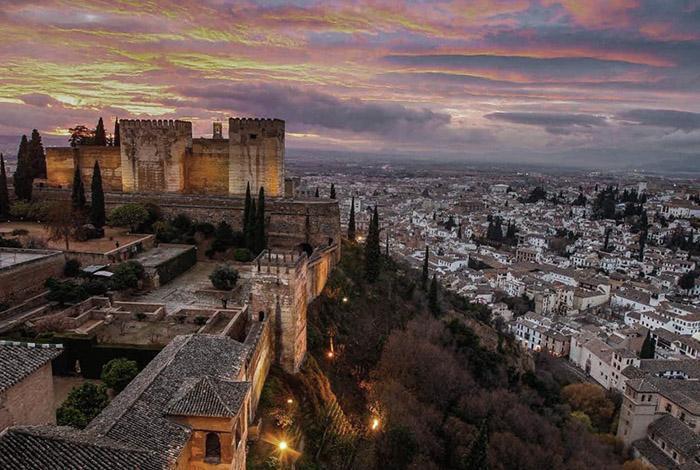Granada: The allure of Andalusia
The soul of the birthplace of flamenco, the Alhambra, and the poet Lorca, which for seven centuries – while it was the capital of the Spanish state – enchanted so many conquerors, you can “hear” it deafeningly on every stone of the cobbled streets in Granada.
It is without a doubt one of the most beautiful and historic cities in Spain. «Give him alms, there is nothing worse in life than being blind in Granada,» said Mexican poet Francisco Icata when he saw a blind beggar on the city streets.
Granada is both medieval and architecturally blessed by the elaborate architecture of the Moorish Arabs. The charming coexistence of Eastern and Western culture in this area of Spain can only be compared to the East-West connection that overflows in Istanbul. Granada is, after all, one of the most diverse, at least in terms of population, Spanish cities, with the Arab, Jewish and Gypsy quarters (Albaicín, Realejo and Sacromonte, respectively) bursting with life.
Brilliant examples of Moorish architecture, famous arabesques, exquisite Renaissance-style buildings, Baroque and Andalusian Baroque, are kept in enviablly pristine condition. Prominent are the Moorish palaces of the Alhambra and the Generalife, which are the most famous monuments of the Muslim heritage of Spain.

This enchanting city of Andalusia is cosmopolitan and famous for its vibrant nightlife. About 3,000 cafés, bars, restaurants and taverns, but also many entertainment venues, where flamenco music and dances occupy a prominent place, are pulsating with life, with a large student population also. One in three residents of the city, after all, is a student!
Rich history
Granada is a city and region (prefecture) in the Autonomous Region of Andalusia. It was built on three hills, at the foot of the Sierra Nevada and at the confluence of two rivers. It is 131 km from Malaga, 248 km from Seville and 415 km from Madrid. The prefecture has around 910,000 inhabitants. It is located on the site of the ancient city of Iliverra or Illiveri. The later history of the city dates back to the 8th century when it was occupied by the Moorish Arabs in 711.
The historical significance of Granada became even greater when the then Christian states (kingdoms) of Europe began to overthrow the Arab kingdoms of Spain, with the result that many Arabs took refuge in Granada, which was their last stronghold. The state that was founded was ruled by two dynasties in succession. Zirí (1048-1163) and Nazarí (1238-1492), until the so-called Catholic Kings, Fernidard of Aragon and Isabella of Castile, captured the city in 1492 and immediately expelled the large number of Jews and Arabs. During the Spanish Civil War (1936-1939) the city fell to Franco’s nationalist forces, but most of the wider prefecture remained in government power until the end of that war.
Lorca
The great poet Federico Garcia Lorca (1898-1936) comes from the village of Fuente Vacero in Granada, where he wrote many of his works. «If you could see what Andalusia really is!» he once wrote to a friend…
He studied philosophy and law at the famous University of Granada. He left Madrid three days before the civil war broke out to return to his hometown, even though he knew he was going to Spain’s most conservative city. Here, a few months later, Franco’s nationalists located him, abducted him and executed him a few kilometers outside Granada.
Lorca was among 10,000 people who died in Granada, the land where he grew up, in the heart of Andalusia. The exact location of the execution remains unknown.

Alhambra
The vivid depiction of Muslim culture in Western Europe is the Alhambra (red in Arabic). The Moorish palace and fortress in Granada, during the Muslim occupation of Spain, built in the 13th century, during the reign of the Nasrid dynasty that ruled the emirate of Granada. After the recapture of the city by the Christians, it became the royal court of the monarchical couple Isabella and Ferdinand. Alhambra today is a palace, a castle, a summer haven and a closed city, all in a single and enchanting place. An attraction of exceptional and rare Islamic architecture. It has been a UNESCO World Heritage Site since 1984.
The Generalife Palace
It was the summer palace and summer residence of the Nasrid sultans of the city. The complex consists of the Atrium of the Canal, in which there is a reservoir surrounded by flower beds, fountains, colonnades, pavilions and the Sultan’s garden. The garden – perhaps the oldest surviving Moorish one of its kind in Spain – is considered to be the best-preserved example of the medieval gardens of old Andalusia. The palace was originally connected to the Alhambra by a covered passage over a gorge, which separated the two palaces. According to the description of the Qur’an and the Islamic world, this place was described as being closest to paradise. It has been a UNESCO World Heritage Site since 1984.
Granada Cathedral
Spain’s second largest cathedral is a magnificent building, built on the former Arabic mosque in the 16th century. To enjoy the temple, stand in the main chapel and look up at the impressive glass windows, sculptures and paintings.
Sacromonte
It is located east of Albayzin and in front of the Alhambra. Sacromonte is one of the most traditional areas of Granada. It is the district of the Roma, who prefer to live in the caves of the area, in cave houses. Although in 1963 the inhabitants of the area were expelled by the dictator Franco, in recent decades the caves have been inhabited again.

University of Granada
Lorca studied philosophy and law here, before poetry won him over. The University of Granada, one of the oldest in the country, was founded in 1531 by Emperor Charles V of Austria. It is one of the most prestigious universities in Spain and has great international recognition. It offers 102 undergraduate degrees and 187 postgraduate programs (master). In addition to its approximately 80,000 undergraduate and postgraduate students, it admits the largest number of Erasmus international students in Europe each year.
- Holy Week is very special for the people of Granada. Each hermandad, ie each parish, makes its own epitaph (pasos), with statues of Christ and the Virgin carried on their backs by young men and men (costaleros). The procession is followed by nazarenos, men dressed in traditional uniforms with pointed hoods, and behind them the «witnesses» who carry the cross of martyrdom on them. From behind come women dressed in traditional black costumes holding crosses and candles. It is usual to have a band that accompanies the course. The weight of the epitaph depends on the dummies and often takes up to 40 men to carry it. The most popular processions are the Silent procession, where the lights go out in the streets and the whole procession takes place in absolute silence and the procession of the Gypsies, where fires are lit in the streets and every now and then the procession stops to sing songs to the Virgin Mary.
- The modern name of the city probably owes to the many pomegranates grown in the area. In Spanish they are called granada. After all, pomegranates are the most common emblems of the city and its inhabitants.











































